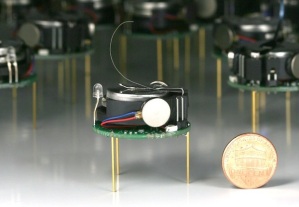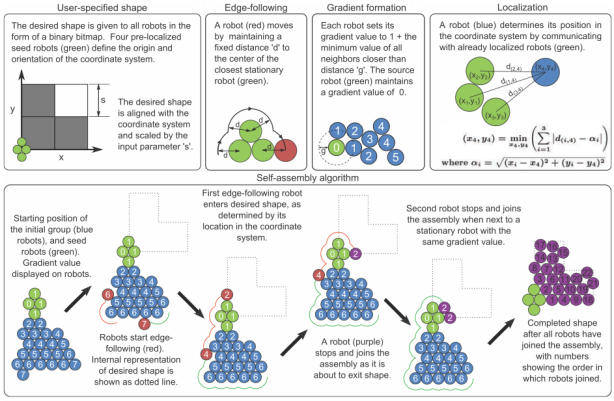Anyone has seen Big Hero 6 probably loves the movie. Anyone who’s seen the flick and actually works in robotics probably loves it ten times more. Unlike many (supposedly) historic blockbusters I’d rather not remember, these guys actually enrolled some very well robotics scientists as consultants and the benefits are obvious: most of the basic stuff is scientifically sound.
For a start, let’s focus on microbots. More specifically on swarms.
Swarm robots are (large-ish) groups of robots that work together. Their collective behavior results from local interactions between the robots and between the robots and the environment in which they act. This research field has been active for a long time now and Marco Dorigo is probably one of the best known scientists in it. Swarms work collectively and without explicit centralized supervision. This means that robots have a global goal and a set of rules to follow, but each robot makes decisions on its own. Hence, we get fault tolerant, scalable and flexible systems, i.e. it does not matter that a handful of robots are not working properly, the strength is in the number.
Obviously, if we want to work with a few hundred robots at a time, they need to be cheap, small and battery savvy (imagine you had to recharge 300 robots every few hours!). A good example of this are Rubenstein’s Kilobots (Harvard University).
 Instead of conventional motors, Kilobots make do with smartphone-like vibration motors, much cheaper, lighter and easy on the batteries. When these motors start to vibrate, they change the center of mass of the robot, actively displacing it forwards (imagine someone pushes you a bit when you are standing: you need to move to regain equilibrium, right?). This is actually the basis of a classic workshop for kids to build the simplest robot using a toothbrush and a smartphone vibration motor.
Instead of conventional motors, Kilobots make do with smartphone-like vibration motors, much cheaper, lighter and easy on the batteries. When these motors start to vibrate, they change the center of mass of the robot, actively displacing it forwards (imagine someone pushes you a bit when you are standing: you need to move to regain equilibrium, right?). This is actually the basis of a classic workshop for kids to build the simplest robot using a toothbrush and a smartphone vibration motor.
If you have two motors, one on each side of the robot, you can also rotate right and left by activating one or the other. Kilobots also talk with each other via infrared communication. Thus, they can calculate approximately where they are with respect to the rest. Using this information, they can collectively adopt any shape simply following three simple rules: edge-following, gradient formation and localization.
The system works as follows. We give ALL robots information about the shape they must adopt and fix a small number of (stationary) robots in a corner of the shape (that becomes our origin of coordinates, i.e. the 0 km of our reference). The rest of the robots will try to estimate their position within the shape with reference to these robots (i.e. the coordinate system). They also keep information about how many robots are between these static robots and themselves (gradient). Robots basically move by following the frontier of the global robot formation (edge following). They keep moving until they decide that they are within the boundaries of the desired shape and they stop when they detect that they are about to leave those boundaries or they collide with a robot with the same gradient value. After a while (unfortunately, several hours, unlike in Big Hero 6) robots manage to organize themselves into the desired shape. Taking into account that we are talking about more than 1000 robots and only these simple rules are used, this is quite a big deal.
So, yup, just planar shapes and quite slow with respect to the movie, but definitely in the same line!
More information on IEEE Spectrum and How Stuff Works
